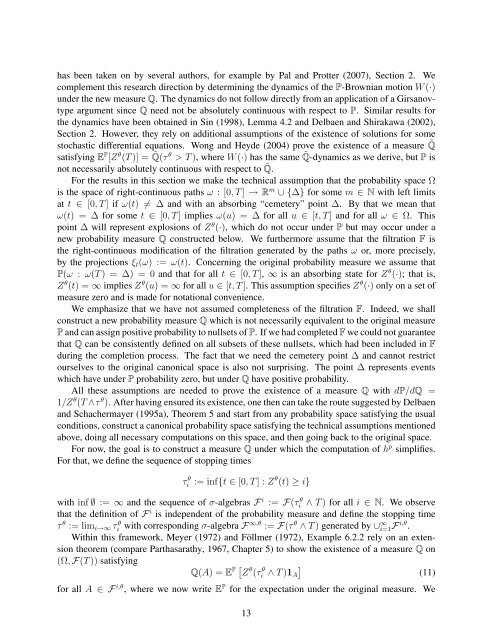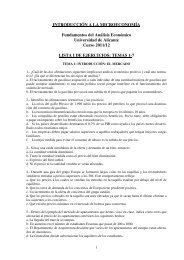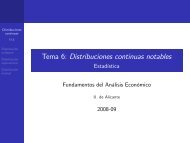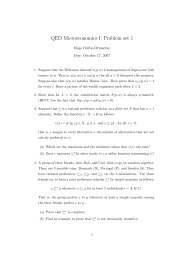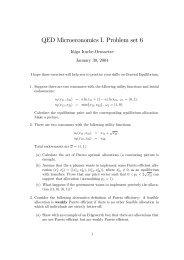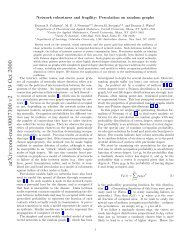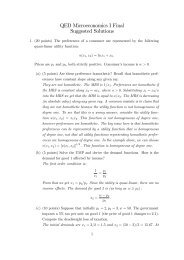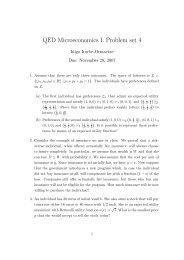Hedging under arbitrage
Hedging under arbitrage
Hedging under arbitrage
You also want an ePaper? Increase the reach of your titles
YUMPU automatically turns print PDFs into web optimized ePapers that Google loves.
has been taken on by several authors, for example by Pal and Protter (2007), Section 2. We<br />
complement this research direction by determining the dynamics of the P-Brownian motion W (·)<br />
<strong>under</strong> the new measure Q. The dynamics do not follow directly from an application of a Girsanovtype<br />
argument since Q need not be absolutely continuous with respect to P. Similar results for<br />
the dynamics have been obtained in Sin (1998), Lemma 4.2 and Delbaen and Shirakawa (2002),<br />
Section 2. However, they rely on additional assumptions of the existence of solutions for some<br />
stochastic differential equations. Wong and Heyde (2004) prove the existence of a measure ˜ Q<br />
satisfying E P [Z θ (T )] = ˜ Q(τ θ > T ), where W (·) has the same ˜ Q-dynamics as we derive, but P is<br />
not necessarily absolutely continuous with respect to ˜ Q.<br />
For the results in this section we make the technical assumption that the probability space Ω<br />
is the space of right-continuous paths ω : [0, T ] → R m ∪ {∆} for some m ∈ N with left limits<br />
at t ∈ [0, T ] if ω(t) �= ∆ and with an absorbing “cemetery” point ∆. By that we mean that<br />
ω(t) = ∆ for some t ∈ [0, T ] implies ω(u) = ∆ for all u ∈ [t, T ] and for all ω ∈ Ω. This<br />
point ∆ will represent explosions of Z θ (·), which do not occur <strong>under</strong> P but may occur <strong>under</strong> a<br />
new probability measure Q constructed below. We furthermore assume that the filtration F is<br />
the right-continuous modification of the filtration generated by the paths ω or, more precisely,<br />
by the projections ξt(ω) := ω(t). Concerning the original probability measure we assume that<br />
P(ω : ω(T ) = ∆) = 0 and that for all t ∈ [0, T ], ∞ is an absorbing state for Z θ (·); that is,<br />
Z θ (t) = ∞ implies Z θ (u) = ∞ for all u ∈ [t, T ]. This assumption specifies Z θ (·) only on a set of<br />
measure zero and is made for notational convenience.<br />
We emphasize that we have not assumed completeness of the filtration F. Indeed, we shall<br />
construct a new probability measure Q which is not necessarily equivalent to the original measure<br />
P and can assign positive probability to nullsets of P. If we had completed F we could not guarantee<br />
that Q can be consistently defined on all subsets of these nullsets, which had been included in F<br />
during the completion process. The fact that we need the cemetery point ∆ and cannot restrict<br />
ourselves to the original canonical space is also not surprising. The point ∆ represents events<br />
which have <strong>under</strong> P probability zero, but <strong>under</strong> Q have positive probability.<br />
All these assumptions are needed to prove the existence of a measure Q with dP/dQ =<br />
1/Z θ (T ∧τ θ ). After having ensured its existence, one then can take the route suggested by Delbaen<br />
and Schachermayer (1995a), Theorem 5 and start from any probability space satisfying the usual<br />
conditions, construct a canonical probability space satisfying the technical assumptions mentioned<br />
above, doing all necessary computations on this space, and then going back to the original space.<br />
For now, the goal is to construct a measure Q <strong>under</strong> which the computation of h p simplifies.<br />
For that, we define the sequence of stopping times<br />
τ θ i := inf{t ∈ [0, T ] : Z θ (t) ≥ i}<br />
with inf ∅ := ∞ and the sequence of σ-algebras F i := F(τ θ i ∧ T ) for all i ∈ N. We observe<br />
that the definition of F i is independent of the probability measure and define the stopping time<br />
τ θ := limi→∞ τ θ i with corresponding σ-algebra F ∞,θ := F(τ θ ∧ T ) generated by ∪ ∞ i=1F i,θ .<br />
Within this framework, Meyer (1972) and Föllmer (1972), Example 6.2.2 rely on an extension<br />
theorem (compare Parthasarathy, 1967, Chapter 5) to show the existence of a measure Q on<br />
(Ω, F(T )) satisfying<br />
Q(A) = E P � Z θ (τ θ �<br />
i ∧ T )1A<br />
for all A ∈ F i,θ , where we now write E P for the expectation <strong>under</strong> the original measure. We<br />
13<br />
(11)


